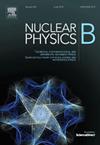Stability and existence of wormhole models in F(Q) gravity generated by holographic dark energy densities
IF 2.5
3区 物理与天体物理
Q2 PHYSICS, PARTICLES & FIELDS
引用次数: 0
Abstract
In this work, we investigate the existence, stability and physical viability of wormhole solutions within the framework of gravity, a modified gravity theory where represents the non-metricity scalar. In this study, we developed wormhole models using holographic dark energy density profiles described by Bekenstein-Hawking and Moradpour, represented as and , respectively. The derived solutions for the wormhole's shape function fulfil the necessary conditions. This study examines the influence of the parameters and on the equilibrium state of the wormhole solution and the breaking of energy conditions. Our findings indicate that each model deviates from the null energy condition, indicating the necessity of exotic matter for the stability of wormholes. Additionally, we analysed the geometry of wormhole models by embedding diagrams. To achieve the physical viability of the wormhole, we examined the active gravitational mass () for both models.
全息暗能量密度产生的F(Q)引力中虫洞模型的稳定性和存在性
在这项工作中,我们研究了F(Q)引力框架下虫洞解的存在性、稳定性和物理可行性。F(Q)引力是一种修正的引力理论,其中Q代表非度量标量。本文利用Bekenstein-Hawking和Moradpour描述的全息暗能量密度曲线,分别用ρbh(r)=Ψ1πr2和ρM=Ψ14πr2(πλr2+1)建立了虫洞模型。虫洞形状函数的推导解满足必要条件。本研究考察了Ψ1和Ψ2参数对虫洞溶液平衡状态和能量破缺条件的影响。我们的研究结果表明,每个模型都偏离了零能量条件,这表明了外来物质对虫洞稳定性的必要性。此外,我们还通过嵌入图分析了虫洞模型的几何形状。为了实现虫洞的物理可行性,我们检查了两个模型的有效引力质量(Mactive)。
本文章由计算机程序翻译,如有差异,请以英文原文为准。
求助全文
约1分钟内获得全文
求助全文
来源期刊

Nuclear Physics B
物理-物理:粒子与场物理
CiteScore
5.50
自引率
7.10%
发文量
302
审稿时长
1 months
期刊介绍:
Nuclear Physics B focuses on the domain of high energy physics, quantum field theory, statistical systems, and mathematical physics, and includes four main sections: high energy physics - phenomenology, high energy physics - theory, high energy physics - experiment, and quantum field theory, statistical systems, and mathematical physics. The emphasis is on original research papers (Frontiers Articles or Full Length Articles), but Review Articles are also welcome.
 求助内容:
求助内容: 应助结果提醒方式:
应助结果提醒方式:


